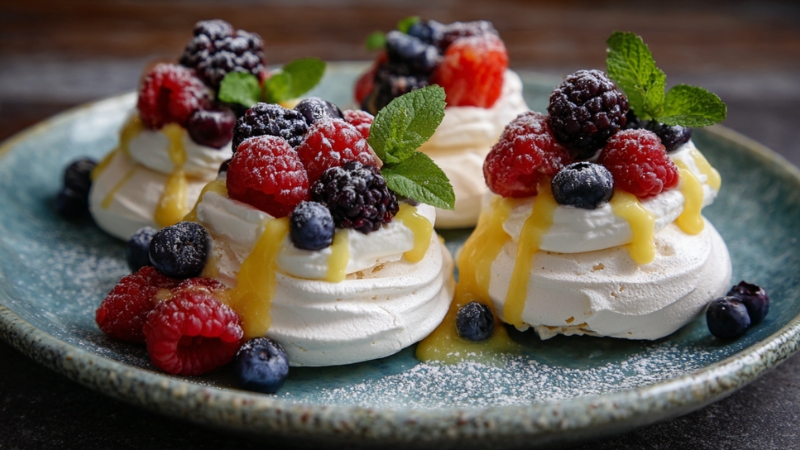When I make mini pavlovas with lemon curd and berries, I stick to a straightforward process: whip egg whites with sugar until stiff and glossy, bake them low and slow until crisp outside and marshmallow-like inside, then top with homemade lemon curd and fresh berries just before serving.
The key steps are making a stable meringue by adding sugar gradually, baking at a consistent low temperature to avoid cracks, and cooling the shells completely before adding the toppings so they stay crisp.
The lemon curd should be smooth, tangy, and not too sweet, while the berries should be fresh and dry so they don’t soften the meringue too quickly.
I have made this recipe enough times to know what can go wrong: meringues weeping, curd turning grainy, or shells collapsing, but if you follow the method here, you can avoid those issues.
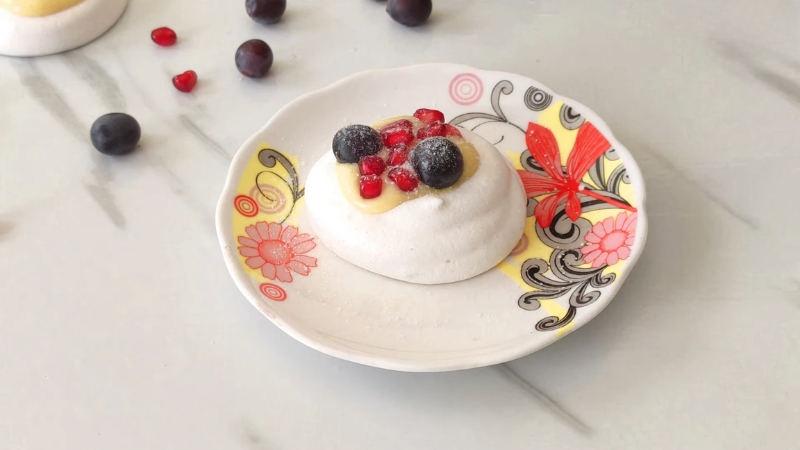
Mini Pavlovas with Lemon Curd and Berries
Equipment
- Electric mixer or stand mixer with whisk attachment
- Mixing bowls
- Baking sheets
- Parchment paper
- Fine-mesh sieve
- Silicone spatula
- Heatproof bowl
- Saucepan for double boiler setup
- Zester or microplane
- Measuring cups and spoons
- Plastic Wrap
Ingredients
Meringue Shells
- 4 large egg whites room temperature
- 1 cup caster sugar superfine
- 2 tsp cornstarch
- 1 tsp white vinegar or lemon juice
Lemon Curd
- 4 large egg yolks from separated eggs
- ¾ cup caster sugar
- ½ cup fresh lemon juice
- 1 tbsp lemon zest
- ¼ cup unsalted butter, cut into small pieces
Toppings
- 300 g mixed fresh berries (strawberries, raspberries, blueberries), washed and well dried
- fresh mint leaves optional, for garnish
Instructions
- Making the Meringue ShellsPreheat oven to 120°C (250°F). Line two baking sheets with parchment paper. If desired, trace 7–8 cm (3-inch) circles as guides, then flip the paper over.Place egg whites in a clean, grease-free mixing bowl. Whip on medium speed until soft peaks form.Gradually add caster sugar, one tablespoon at a time, whisking well between each addition. Continue whipping until stiff, glossy peaks form and no sugar grains remain when rubbed between fingers.Sift in cornstarch and add vinegar. Gently fold in with a spatula.Spoon meringue onto parchment, shaping into nests with an indentation in the center.Bake for 1 hour 15 minutes, until dry to the touch but still pale. Turn off oven and cool meringues inside with the door slightly ajar to prevent cracking.
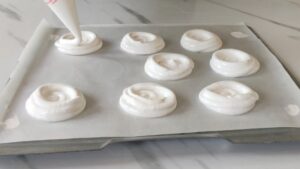
- Preparing the Lemon CurdIn a heatproof bowl, whisk egg yolks, sugar, lemon juice, and zest until smooth.Place bowl over a saucepan of simmering water (double boiler setup). Stir constantly with a silicone spatula for 8–10 minutes, until thick enough to coat the back of a spatula.Remove from heat. Stir in butter, a few pieces at a time, until melted and incorporated.Strain curd through a fine sieve into a clean bowl for smoothness.Press plastic wrap directly onto surface and refrigerate until fully cooled.
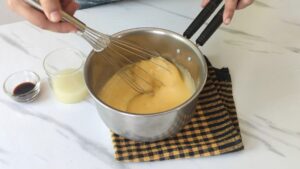
- Assembling the PavlovasJust before serving, place each cooled meringue on a serving plate.Spoon a generous dollop of lemon curd into the center.Top with fresh berries and optional mint leaves for garnish.Serve immediately to preserve crisp texture.
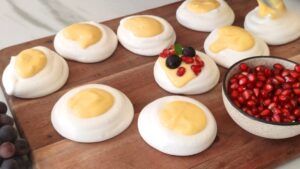
Video
Notes
Cooking Tips
- Use room temperature egg whites for maximum volume and stability.
- Gradual sugar addition is critical—don’t rush it, or the meringue will turn gritty or weep.
- Ensure your mixing bowl is grease-free—even a hint of fat will prevent the egg whites from whipping properly.
- To avoid sticky shells in humid climates, store meringues with a silica gel packet (non-edible, avoid contact with food).
- Straining the curd is optional but creates a luxurious texture.
- Assemble just before serving to prevent soggy bottoms.
Storage and Make-Ahead Tips
View this post on Instagram
From experience, I can tell you that meringue shells keep well in an airtight container at room temperature for up to 3–4 days, as long as the weather isn’t too humid. Lemon curd lasts in the fridge for about a week.
You can prepare both components in advance and assemble them at the last moment for maximum texture contrast, crisp meringue, smooth curd, and fresh berries.
If you live in a humid climate, storing meringues with a small packet of silica gel (kept away from food contact) can help keep them crisp.
Troubleshooting
Over the years, I have had some failures with pavlovas, and here’s what I learned:
Problem
Likely Cause
Solution
Meringue weeps sugar syrup
Sugar not fully dissolved; oven too hot
Add sugar gradually, and bake at a lower temperature
Shells collapse
Undercooked or cooled too quickly
Bake longer, cool in oven with door ajar
Curd is grainy
Overheated or cooked too fast
Use gentle heat, stir constantly
Shells are sticky after storage
Humid environment
Store in an airtight container with silica gel
Final Notes
@frontier_coopMini Pavlovas 🍋🌼 These stunning treats are the perfect balance of crisp meringue, pure vanilla extract, and tangy lemon curd. Save the RECIPE below. 👇 Pavlovas: 6 large egg whites, room temp. 1 1/2 cups Frontier Co-op® Organic, Fair Trade Cane Sugar 2 tsp. Frontier Co-op® Pure Vanilla Extract 2 tsp. Frontier Co-op® Cornstarch Lemon Curd: 2 whole eggs 2 egg yolks 3/4 cup Frontier Co-op® Organic, Fair Trade Cane Sugar 1/2 cup freshly squeezed lemon juice 1 Tbsp. lemon zest 1/4 tsp. Frontier Co-op® Sea Salt 1/2 cup unsalted butter, cold and cut into pieces 1 tsp. Frontier Co-op® Pure Vanilla Extract For topping: Blueberries, mint sprigs, lemon zest Preheat oven to 225 degrees and line two baking sheets with parchment paper. In a mixer on medium speed, beat egg whites for about 1 minute, until frothy. Then, while continuing to beat on medium speed, add sugar 1 spoonful at a time, letting it mix in for 15 to 20 seconds after each addition. Beat for about 10 minutes, or until the egg whites are glossy, thick and hold stiff peaks. Add vanilla extract and cornstarch and continue mixing until incorporated. Transfer mixture to a piping bag fitted with a star tip. Pipe a base disk on the bottom, then pipe two circular layers up the sides to form a “nest” shape. Bake for 1 1/2 hours, then turn off oven and let pavlovas cool in oven. To a saucepan, add eggs, egg yolks, sugar, lemon juice, lemon zest and salt, and whisk to combine. Heat over medium-low heat, stirring until sugar has dissolved. Add butter, a few pieces at a time, stirring until each addition is fully incorporated. Do not let curd come to a simmer, keep it at medium-low heat and stir constantly to prevent eggs from cooking. Continue cooking for a few minutes, until curd starts to thicken. Whisk in vanilla extract. Refrigerate while pavlovas are baking — the curd will thicken more as it cools. When pavlovas are done and cooled, fill each nest with lemon curd, then top with fresh blueberries and garnish with mint and lemon zest.
Making mini pavlovas with lemon curd and berries has become one of my go-to desserts for gatherings. The recipe is flexible; you can swap the lemon curd for passion fruit curd, add whipped cream under the berries, or use seasonal fruits.
I also sometimes prepare a blueberry lemon cheesecake waffle for brunch events, as it carries the same bright citrus note but in a more indulgent, breakfast-style form.
The key for me has always been balance: the sweetness of the meringue should be offset by the tartness of the curd and the freshness of the berries.
I’ve served these at small family dinners and larger parties, and they are always well-received because they look elegant but are easy to eat individually. They also allow me to prepare most of the work ahead, leaving just a few minutes of assembly before serving.
If you follow the steps above, gradual sugar addition, low-and-slow baking, smooth curd preparation, and last-minute assembly, you’ll have mini pavlovas that hold their shape, taste bright, and have that perfect combination of crisp, creamy, and juicy in every bite.

